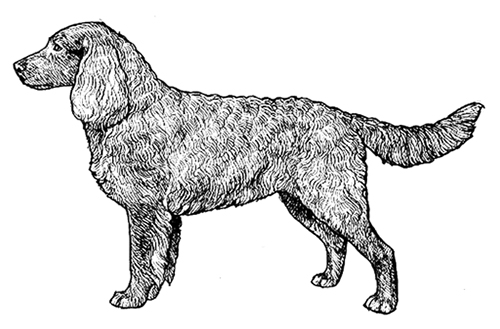American Water Spaniel
Gun Dog Group
The goals and purposes of this breed standard include: to furnish guidelines for breeders who wish to maintain the quality of their breed and to improve it; to advance this breed to a state of similarity throughout the world; and to act as a guide for judges. Breeders and judges have the responsibility to avoid any conditions or exaggerations that are detrimental to the health, welfare, essence and soundness of this breed, and must take the responsibility to see that these are not perpetuated.
Any departure from the following should be considered a fault, and the seriousness with which the fault should be regarded should be in exact proportion to its degree and its effect upon the health and welfare of the dog and on the dog’s ability to perform its traditional work.
History
The breed is "American made." It was developed in the Wolf and Fox River Valley region of East-Central Wisconsin. The rivers and large lakes they feed - Poygan, Butte des Morts and Winnebago - provided a waterfowl gunner's paradise in the late 1800's. They required a sturdy little dog that could shake off the cold and work marsh cover, yet could fit into a small canoe or skiff. It was for this purpose the breed was developed. Some say the breed developed from crosses of the now extinct English Water Spaniel, Irish Water Spaniel and the Flat Coated Retriever. On February 8, 1920, the UKC registered the first American Water Spaniel, "Curly Pfeifer", named after Dr. F.J. Pfeifer, the first person to register the breed. By 1924, his kennel had developed the breed to the level of having three generations of his line of dogs and as a result was given the Purple Ribbon status. (At least three generations of the ancestors registered with UKC).
The American Water Spaniel was recognized by the United Kennel Club in 1920.
General Appearance
The American Water Spaniel is a moderate-sized hunting dog, weighs from 25 to 45 pounds, is from 15 to 18 inches high at the withers, and is compact. It has a curly coat that is dark brown to liver in color, with a moderate length, rocker shaped, hair covered-tail.
Working dogs are not to be penalized under any conditions for scars or blemishes that are due to hunting injuries.
Disqualifications: Unilateral or bilateral cryptorchid.
Characteristics
A sturdy little dog, with a good nose and a fondness for water, he is a busy worker, both eager to please and easily trained.
Disqualifications: Viciousness or extreme shyness.
Head
SKULL
Rather broad and full, moderate in length. Stop moderately defined. Forehead covered with short smooth hair and without tuft or topknot.
MUZZLE
Of medium length and square, with no inclination towards snipiness.
TEETH
A full complement of strong, straight, well shaped, white teeth meet in a bite that is neither undershot nor overshot.
EYES
Well set apart, and somewhat round in shape. Color, hazel or brown, or of dark color to harmonize with the coat.
Disqualification: Yellow (lemon) eyes.
NOSE
Sufficiently wide and with well-developed nostrils to insure good scenting power.
EARS
Long, wide and lobular, set slightly above the level of the eye. Leather extending to end of nose and well-covered with close curls.
Neck
Round and of medium length, strong and muscular, free of throatiness, set to carry head with dignity; arched, but not accentuated.
Forequarters
Shoulders sloping, clean and muscular.
FORELEGS
Medium length, powerful, well boned and reasonably straight. Dewclaws may be present.
Body
General outline gives the impression of a symmetrical relationship of parts. Body is well-developed, sturdily constructed, but not too compactly coupled. Brisket deep, but not excessively broad. Well-sprung ribs. Strong loins slightly arched, without a tucked-up appearance.
Hindquarters
HIND LEGS
Muscular, with suitably bent stifles and strong, well let down hocks that are rounded, not sharp or pointed in shape.
Feet
Feet in proportion with size of dog. Toes closely coupled, well-padded and webbed.
Tail
Is of moderate length, slightly curved in a rocker shape. Carried below the level of the back, tapered and covered with hair to tip. Action is lively.
Faults: Rat or shaved tailed.
Coat
The coat should be closely curled or have marcel effect and should be of sufficient density (and texture) to be protection against the elements.
Faults: Coat too straight, soft, coarse, fine or tightly kinked.
Color
Solid liver or dark chocolate. A little white on toes or chest is permissible.
Disqualification: Albinism.
Height & Weight
Height ranges from 15 to 18 inches for either sex. Males, 28 to 45 pounds; females, 25 to 40 pounds.
Gait
Well-balanced, with matching front reach and rear drive. No tendency for legs to cross over or interfere with one another. Hind legs move nearly parallel to front legs when viewed from behind.
Disqualifications
(A dog with a Disqualification must not be considered for placement in a conformation event, and must be reported to UKC.)
Unilateral or bilateral cryptorchid.
Viciousness or extreme shyness.
Albinism. Yellow (lemon) eyes.

Looking for a Dog?
Find a dog that will fit your family.
Note: The breeders on this list are not endorsed by UKC.
Revised June 1, 2012
©Copyright 1992, United Kennel Club
